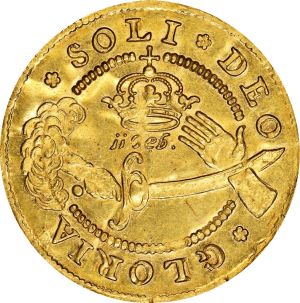Denmark 1659 3 ducats Fr-127
This specimen was lot 1070 in Stack's Bowers sale of the L. E. Bruun Collection (Copenhagen, September 2024), where it sold for €78,000 (about US$86,440 including buyer's fees). The catalog description[1] noted,
"Superbly Struck and Lustrous Triple Ducat, Considered Unique Outside of a Museum, Featuring the Hand of the King of Sweden Being Severed by the Sword of Justice, DENMARK. 3 Ducats, 1659. Copenhagen Mint. Frederik III. NGC MS-62. Mintmaster: Henrik Köhler. The 3 Ducat has consistently ranked among the most popular of all Danish coins and has for the last 100 years been considered unattainable, but here it is in completely spectacular condition, superbly struck and with almost full original luster. For the denomination, the only two known examples are one on the National Museum of Denmark and a pierced one in Münzkabinett der Staattichen Museen in Berlin."
Friedberg mentions a double portugaloser (20 ducats, Fr-122), a single portugaloser (10 ducats, Fr-123), six ducats (Fr-125), five ducats (Fr-124), four ducats (Fr-126) and three ducats (shown here) for 1659. All are rare and Fr-122 is unique. In their sale of an Ebenezer four ducats, Heritage commented, "Though the Swedish king, Carl X Gustav, had achieved a crushing victory against the Danes during his February 1658 invasion of the kingdom as part of the Northern Wars, leading to the Treaty of Roskilde that gave Sweden huge territorial gains, he nonetheless resolved to wipe his rival from the map of Europe. In the ensuing attack, the Swedish armies, which had never left Denmark after the peace treaty was concluded, laid siege to Copenhagen. After withstanding the siege for six months, the Danes were able to make use of the Swedes' impatience, aided by spy intel and the help of 600 Dutch marines, and ambushed the Swedish army during their hastily planned assault of Christianhavn and Slotsholmen, resulting in a crushing Swedish defeat that led to long-term peace between Denmark, Sweden, and Norway. It is quite likely that pieces such as this were minted as tokens of appreciation, distributed by the King himself to the officers involved in defending the city."
Recorded mintage: unknown.
Specification: 10.5 g, 0.979 fine gold, this specimen 10.47 g.
Catalog reference: Fr-127; KM-PnA16; Hede-99; Sieg-52; Schou-8; Aagaard-74.1 (59-E1/59-E1); Bruun-6276.
- Cuhaj, George S., and Thomas Michael, Standard Catalog of World Coins, 1601-1700, 6th ed., Iola, WI: Krause Publications, 2014.
- Davenport, John S., European Crowns, 1600-1700, Galesburg, IL, 1974.
- Friedberg, Arthur L. and Ira S. Friedberg, Gold Coins of the World, From Ancient Times to the Present, 9th ed., Clifton, NJ: Coin and Currency Institute, 2017.
- Siegs Møntcatalog 2016: Danmark med Omrader, 48 ed., Frederikssund, Siegs Forlag ApS, 2015.
- [1]Orsini, Matt, Kyle Ponterio, Jeremy Bostwick and Henrik Holt Christensen, The L. E. Bruun Collection - A Corpus of Scandinavian Monetary History Part I, Costa Mesa, CA: Stack's Bowers Galleries, Inc., 2024.
Links to:
- 1655-HK 5 ducats (½ portugaloser)
- 1657 ducat
- 1657-HK speciedaler
- Denmark-Gluckstadt 1659-IS sosling
- Denmark-Gluckstadt 1659-IS 1/16 speciedaler
- Denmark-Gluckstadt 1659-IS krone Dav-3675
- 1659 2 mark
- 1659 krone, shield reverse
- 1659 krone, sword smiting hand, "*IIII*MARCK*DANSKE*"
- 1659 krone, sword smiting hand, "DOMINVS PROVIDEBIT"
- 1659 half ducat
- 1659 "Ebenezer" 4 ducats
- 1659 "Ebenezer" 5 ducats
- 1659 "Ebenezer" 10 ducats (portugaloser)
- 1660-IS krone
- 1660 quarter ducat
- 1661 ducat
- 1662 double ducat
- Coins and currency dated 1659

